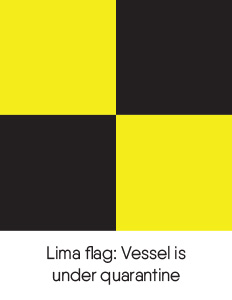COVID-19 is affecting everyone’s cruising plans this season. Mine included. My annual trek up the Inside Passage to Alaska with the Waggoner Flotilla was cancelled. Many of us are in the same boat, regardless if our plans were to cruise the San Juan Islands, explore the Inside Passage, or compete in a sailboat regatta or long-distance race.
Even after the immediate impact of COVID-19 passes, it has permanently reshaped the way we cruise.
We can no longer assume a destination community will welcome us with open arms. It’s also been “a shot across the bow” from a risk— contagious disease on board either underway or in port—largely ignored by Pacific Northwest cruisers and distance racers.
For as long as humans (and animals) are on earth, there will be contagious disease. The threat isn’t just epidemics like the current one, but “normal” contagious diseases such as a norovirus or flu. There are also food-borne illnesses such as E.coli or salmonella caused by pathogenic bacteria. For a cruising boat, an incapacitated skipper or key crew member threatens safety of the entire boat and crew, even if the others do not become sick.
So, for those planning to go cruising, whether sooner or later, what contagious disease procedures should a Pacific Northwest cruiser consider?
For guidance on this, I asked Dr. Ann Jarris, a board-certified emergency medicine physician and co-founder and CEO of Discovery Health MD. As experts in maritime and remote medical risk management, the company’s motto is, “We Bring Mariners Home Safely.”
 Among the services that Discovery Health MD provides are medical chest design and SeaDoc® Medical Advisory Services, which provides remote medical consultation support to both fishing and private vessels. The company also assists with ship diversion and medical evacuation coordination. Dr. Jarris has sailed as an expedition team physician to Antarctica with Quark Expeditions and understands the challenges of a medical issue on board in remote places.
Among the services that Discovery Health MD provides are medical chest design and SeaDoc® Medical Advisory Services, which provides remote medical consultation support to both fishing and private vessels. The company also assists with ship diversion and medical evacuation coordination. Dr. Jarris has sailed as an expedition team physician to Antarctica with Quark Expeditions and understands the challenges of a medical issue on board in remote places.
Here’s a small sample of the items posted at Discovery Health MD that I found interesting and thought-provoking:
- Identify what the minimum safe staffing requirements are for a vessel in case of a widespread isolation or quarantine. I think this is a key question that many would-be cruisers don’t want to consider, but need to. What happens if even the captain alone gets sick? Is there someone else on board that can perform all the day-to-day operations of the vessel, including emergency response?
- Identify which rooms (cabins) will be used for isolation of sick crew and identify which rooms will be used to quarantine crew with close contact exposure to a suspected COVID-19 case if necessary. If the vessel does not have separate isolation facilities, consider the entire vessel under quarantine. Restrict access to rooms used for isolation or quarantine for at least two hours after the sick person has left the room/cabin.
- Identify local lodging options if you have to leave sick crew on shore. Identify contact information for local medical clinics if you have a suspected COVID-19 case. “If you have a crew member get sick on board, you can’t just drop them off someplace on shore and take off again,” offers Dr. Jarris. “That’s not happening. People need to think about that. If you get to someplace like Alaska, with a mandatory 14-day quarantine period, and someone on board your boat is sick, you don’t get to just get off your boat and go to the hospital.”
- Ensure adequate PPE is available on board. Have a disposal plan in place as soiled PPE should be stored in sealed, watertight garbage bags. Recreational boats need to think not only about the challenges of getting PPE, but also storing used PPE safely as waste facilities ashore become harder to access.
- The galley should be prepared to send individual meals to crew and clean dishes separately. Consider use of single-use cups, plates, etc., but it’s challenging to store that much waste on even fairly large recreational cruisers.
- It is recommended to minimize crew changes. Once a vessel crew has been established, undergone 14 days without illness, and has had no new COVID-19 exposure, it is recommended that that healthy crew remain with the vessel for the season. No more port-to-port crew (or crew that just join you for individual legs of the trip). For many cruisers, this means the difficult question of considering who you would invite on board if you know they might be with you for the entire voyage.
We’re all looking forward to the end of COVID-19 and being able to go cruising again more freely! The lessons learned from this experience will hopefully help each of us develop a more robust plan for preparing for a contagious disease on board.
To access the entire list of Discovery Health MD COVID-19 response recommendations, visit
discoveryhealthmd.com/coronavirus-corner/#onboard.